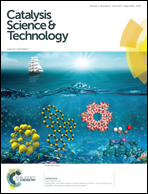Synthesis and characterization of rare-earth metal complexes supported by a new pentadentate Schiff base and their application in heteroselective polymerization of rac-lactide†
Abstract
A series of neutral rare-earth metal aryloxides and amides supported by a new pentadentate (N2O3) salen ligand were synthesized, and their catalytic behaviors for the ring-opening polymerization of rac-lactide (rac-LA) were explored. The protolysis reactions of N,N′-bis(3,5-di-tert-butylsalicylidene)-2,2′-diaminodiphenyl ether (LH2) with (ArO)3Ln(THF) (ArO = 2,6-But2-4-MeC6H2O) and Ln[N(SiMe3)2]3 in a 1 : 1 molar ratio in THF gave the neutral rare-earth metal aryloxides LLn(OAr)(THF)n [n = 0, Ln = Sc (1), Yb (2); n = 1, Ln = Y (3), Sm (4) and Nd (5)] and rare-earth metal amides LLnN(SiMe3)2 [Ln = Yb (6), Y (7)], respectively. X-ray structural determination showed that complexes 1, 2, 6 and 7 have monomeric structures, in which the coordination geometry around the rare-earth metal atom can be best described as a distorted trigonal prism. Complexes 3 and 5 are THF-solvated monomers and each of the rare-earth metal atoms is seven-coordinated to form a distorted capped trigonal prism. It was found that all of these complexes can efficiently initiate the ring-opening polymerization (ROP) of rac-LA to give heterotactic-rich polylactides (PLAs). The highly heterotactic PLA (Pr up to 0.93) was obtained using complex 2 as the initiator at a polymerization temperature of 0 °C. The observed increasing order of activity of 1 < 2 < 3 < 4 ≈ 5 is in agreement with the order of their ionic radii, whereas the order of stereoselectivity is in the reverse order. The rare-earth metal salen amides can initiate rac-LA polymerization in a controlled manner, while polymerization using the rare-earth metal salen aryloxides is less controlled at room temperature.


 Please wait while we load your content...
Please wait while we load your content...